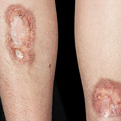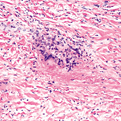Necrobiosis Lipoidica Diabeticorum
General Information
Necrobiosis Lipoidica Diabeticorum is a degenerating disease of the connective tissue of the skin particularly of the lower extremities. Plaques begin to develop with a red-brown color but progress to a yellow and atrophic appearance. The plaques slowly grow over a period of months to years, some pruritus and pain may occur. The cause remains unknown, although most theories link the disease to patients that have diabetes mellitus. A renaming of the disorder was suggested when patients without diabetes were appearing with the disease, today the term necrobiosis lipoidica encompasses all patients with our without diabetes showing the same clinical lesions. Topical and intralesional steroids can lessen the inflammation on earlier stages of the condition. Ultraviolet light treatment has been found to control the condition when it is flaring. Some other medications that may be helpful include aspirin, fibrinolytic agents, nicotinamide, pentoxifylline, heparin, antiplatelet agents, ticlopidine, tretinoin and cyclosporine.
Epidemiology
Occurs in about 3% of patients with diabetes, about 2/3 of cases are patients with diabetes
Etiology
Unknown, linked to diabetic microangiopathy
Pathogenesis
Disorder of collagen degeneration with a granulomatous response, thickening of blood vessel walls, and fat deposition
Clinical
1 – 3 mm well-circumscribed papules or nodules, which develop a porcelain-like appearance
Histology
Altered collagen that loses its normal eosinophilic coloration and fibrillar appearance, becoming slightly bluish and “smudged”
Bibliography
1. “Necrobiosis Lipoidica” (Online). January 2007. http://www.emedicine.com/DERM/topic283.htm (visited: March 25, 2008) 2. “Necrobiosis Lipoidica Diabeticorum” (Online). http://www.health-disease.org/skin-disorders/necrobiosis-lipoidica-diabeticorum.htm (visited: March 25, 2008)
Download PDF
![]() Necrobiosis Lipoidica Diabeticorum
Necrobiosis Lipoidica Diabeticorum


